Centauri Dreams
Imagining and Planning Interstellar Exploration
Are Planets Like Proxima b Water Worlds?
Those of us fascinated by dim red stars find these to be exhilarating days indeed. The buzz over Proxima b continues, as well it should, given the fact that this provocative planet orbits the nearest star. We also have detections like the three small planets around TRAPPIST-1, another red dwarf that is just under 40 light years out in the constellation Aquarius. These are small stars indeed, just 8 percent the mass of the Sun in the case of the latter, while Proxima Centauri is about 10 times less massive (and 500 times less luminous) than the Sun.
But just what might we find on planets like these? A new paper from Yann Alibert and Willy Benz (University of Bern) drills down into their composition. The researchers’ goal is to study planet formation, with a focus on planets orbiting within 0.1 AU, a range that includes the habitable zone for such stars. While a forthcoming paper will look at the formation process of these planets in greater detail, the present work studies planetary mass, radius, period and water content.
To do this, Alibert and Benz have developed computer simulations that model red dwarf planetary systems, assuming a central star with a tenth the mass of the Sun and a protoplanetary disk around each modeled star. Putting the model into motion, the scientists studied a series ranging from a few hundred to thousands of such stars, with 10 planetary embryos in each disk — each embryo was modeled as having an initial mass equal to that of the Moon, and the initial location of each planetary embryo was drawn at random.
The results, according to Alibert:
“Our models succeed in reproducing planets that are similar in terms of mass and period to the ones observed recently. Interestingly, we find that planets in close-in orbits around these type of stars are of small sizes. Typically, they range between 0.5 and 1.5 Earth radii with a peak at about 1.0 Earth radius. Future discoveries will tell if we are correct!”
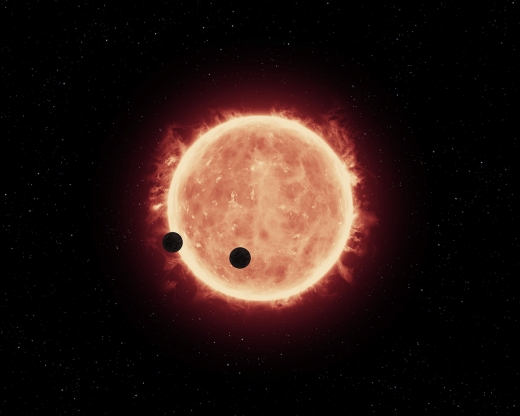
Image: Artist’s impression of Earth-sized planets orbiting a red dwarf star. Credit: @ NASA, ESA, and G.Bacon (STScI).
The most striking aspect of this work is likely to be Alibert and Benz’ findings on the water content of small planets in the habitable zone. The amount of water is found to depend upon the location at which the planet has accreted planetesimals, their composition being dictated by the thermal structure of the disk and the location of the snowline, which varies depending on disk mass. Note this: A significant fraction of the planets modeled show more than 10 percent water. Contrast this with the Earth, whose fraction of water is roughly 0.02%.
The study shows a correlation between the mass of a planet and the water fraction, with planets that do not contain a high degree of water being lower in mass (generally below one Earth mass), while planets totally devoid of water are all less massive than one Earth mass. Alibert and Benz see this as the result of migration, with more massive planets migrating from further out in the system, thus collecting water-rich material from beyond the snowline.
Water may be a key to habitability, and the ‘habitable zone’ is defined as the zone in which liquid water can exist on the surface. But water to the extent of deep global oceans is problematic. A large enough water layer can produce high pressure ice at the bottom, preventing the carbonate-silicate cycle that regulates surface temperature over long timescales from operating. Without this mechanism, atmospheric CO2 cannot cycle through the weathering of rocks on the Earth’s surface and the eventual subduction of calcium carbonate. High temperatures and pressures eventually return CO2 to the atmosphere by processes like volcanism, regulating global temperatures.
We don’t know how much of a factor the loss of this process might be on planets around red dwarf stars, as the paper takes pains to note:
In the case of low mass stars, which evolve on much longer timescales, this may not be a major problem, as the stellar flux varies on timescales much longer than in the case of the Sun. In this situation, a process that stabilizes the surface temperature may not be necessary. The second reason [why large amounts of water may be detrimental for habitability] is connected to the fact that for planets with too much water an unstable CO2 cycle destabilizes the climate making habitability more challenging… Again, this was demonstrated for solar-type stars and a similar process may or may not exist for low mass stars.
So we have a computer model that produces planets similar in mass and radius to the interesting worlds we’re finding around some nearby red dwarfs, with a peak in the distribution of radius at about one Earth radius. The authors argue that the properties of the disk potentially correlate with the mass of the star, thus determining the water content of emerging planets. Deep oceans on planets in the habitable zone of red dwarfs may be the norm, in which case we need to know a great deal more about climate on such exotic worlds.
…our models show that the properties of the disk and their potential correlation with the mass of the star are the most important parameters determining the characteristics, in particular the water content, of the emerging planet population. In this context, observational constraints on mass and lifetime of discs in orbit of low-mass stars become of paramount importance.
The paper is Alibert and Benz, “Formation and composition of planets around very low mass stars,” accepted at Astronomy & Astrophysics (preprint).

A Microlensing Opportunity for Centauri A
First light for the European Extremely Large Telescope (E-ELT) is scheduled for 2024, a useful fact given that a few years later, we may be able to use the instrument in a gravitational lensing opportunity involving Alpha Centauri. Specifically, Centauri A is expected to align with the star 2MASS 14392160-6049528, thought to be a red giant or supergiant and far more distant than Alpha Centauri. This will create an event that not just the E-ELT but other instruments, like the GRAVITY instrument on the Very Large Telescope Interferometer (VLTI), will be able to study — GRAVITY is capable of extremely high accuracy astrometry.
A team of French astronomers led by Pierre Kervella (CNRS/Universidad de Chile) is behind this new study, which involved fine-tuning our knowledge of the trajectories of Centauri A and B. Remember that we see gravitational lensing when a massive object like a star distorts the spacetime around it, so that light from the more distant object must follow a curved path to reach us. The amount of mass in the closer star affects the extent of this deflection, and when one or more planets orbit the star, they become theoretically detectable.
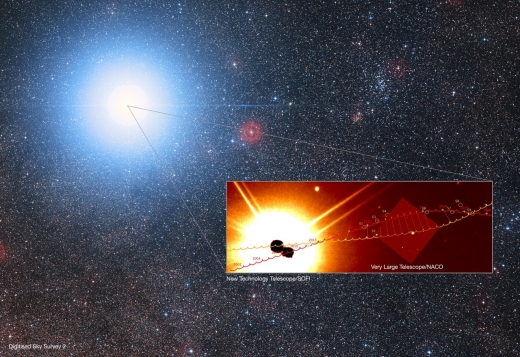
Image: The predicted trajectory of Alpha Centauri A and B. Credit: ESO.
The Centauri A event is to occur in 2028, by which time we may well have knowledge of other planets around one or more of the primary Alpha Centauri stars. But a particularly useful aspect of microlensing is that it is not reliant on proximity to the star. Unlike transit studies or radial velocity analysis, which can produce evidence for a close-in planet quickly but require lengthy study for planets further out in the system, microlensing allows us to spot planets in wider orbits, even if the observation in which we find them is transitory and does not repeat.
So this lensing event is another potential window into this intriguing system, around which at present we know only of the world orbiting Proxima Centauri. Recall that the latter has also been studied in two microlensing events, one in October of 2014, the second in February of 2016. We found Proxima b through radial velocity methods (although the star was also the subject of transit studies), but microlensing is useful even when it fails to turn up planets, since it gives us a way of refining our estimates of a given star’s mass.
Alpha Centauri gives us serious opportunities for microlensing because the star field behind it is densely populated, thanks to the system’s location near the plane of the galaxy as seen from Earth. The Kervella paper studies conjunctions with background stars that will occur in coming decades, based on observations of the field surrounding Alpha Centauri that Kervella and co-author Fréderic Thévenin (Observatoire de la Côte d’Azur) began over a decade ago.
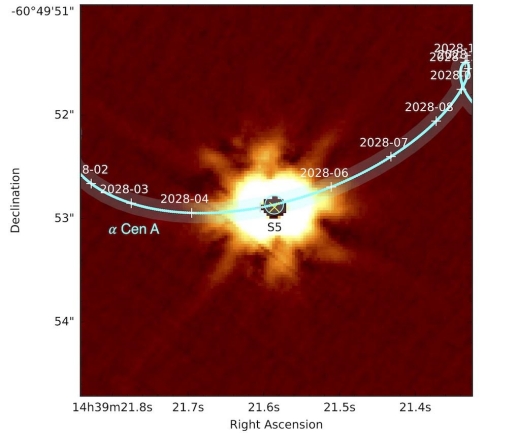
Image: An enlargement of the conjunction that will occurs in 2028, with the Einstein ring of Alpha Cen A represented in cyan color. Credit: Pierre Kervella.
The conjunction of Centauri A with 2MASS 14392160-6049528 is the most favorable of the conjunctions involving Alpha Centauri over the next three decades. From the paper, which references the background star as S5; i.e., one of the background stars numbered in the survey:
During the approaches, astrometric measurements will reveal the relativistic deflection of the background star light with a high signal to noise ratio. For the conjunction with S5, we may be able to directly observe the gravitational splitting of the distant source image using the E-ELT, VLTI/GRAVITY or ALMA. The astrometric monitoring of the relative positions of ??Cen and the S stars may reveal the presence of planets through secondary gravitational lensing. In addition, the light from the background star will possibly be subject to photometric variations induced by transits of low mass objects present in the ??Cen system.
Potential results include, in other words, everything from high and low mass planets to asteroids and comets. The authors believe the conjunctions in coming decades will give us highly accurate information about the Alpha Centauri stars’ proper motion, orbital parameters and parallax values. And note this: “This accuracy will be valuable for high-precision modeling of the two stars of ??Cen, and for the preparation of the recently announced Breakthrough Starshot initiative to send ultra-fast light-driven nanocrafts to ??Centauri.”
The Kervella paper is “Close stellar conjunctions of ? Centauri A and B until 2050,” Astronomy & Astrophysics 594 (2016), A107 (abstract). On microlensing and Proxima Centauri, see Sahu et al., “Microlensing Events by Proxima Centauri in 2014 and 2016: Opportunities for Mass Determination and Possible Planet Detection,” Astrophysical Journal Volume 782, Issue 2 (2014). Abstract available.

Red Dwarfs: Oldest Known Circumstellar Disk
Determining the age of a star is not easy, but one way of proceeding with at least some degree of confidence is to identify the star as a member of a stellar association. Here we’re talking about a loose cluster of stars of a common origin. Over time, the stars have begun to separate, but they still move together through space. It was the Armenian astronomer Viktor Ambartsumian, the founder of the Byurakan Observatory, who discovered the nature of these associations and demonstrated that they were composed of relatively young groups of stars.
Stellar associations, or young moving groups (YMGs), provide an outstanding place to study the evolution of protoplanetary disks around young stars, for all associated stars have a similar age. Indeed, their galactic motion can be traced back to their place of origin. Another benefit: Exoplanets in such infant systems are often still hot, well within the capabilities of our near-infrared direct imaging techniques. Many direct imaging and disk evolution surveys in recent years have focused on the members of young moving groups.
Without Ambartsumian’s discovery of these groups, we would be hard pressed to come up with the age of the interesting red dwarf tagged AWI0005x3s. We’ve just learned, through a team led by Steven Silverberg (University of Oklahoma), working with a group of citizen scientists using the Disk Detective site, that this star has a warm circumstellar disk, an interesting find in its own right because we haven’t found many disks around red dwarfs.
But AWI0005x3s is found in the Carina association, on the order of 200 light years away in the Carina nebula, and appears to be moving with it. That pegs the young red dwarf as highly unusual, as Silverberg explains:
“Most disks of this kind fade away in less than 30 million years. This particular red dwarf is a candidate member of the Carina stellar association, which would make it around 45 million years old [like the rest of the stars in that group]. It’s the oldest red dwarf system with a disk we’ve seen in one of these associations.”
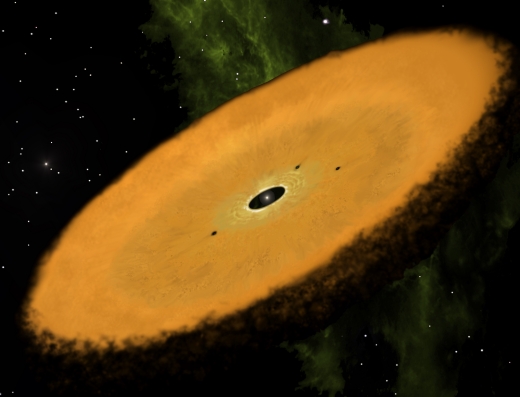
Image: Artist’s concept of the newly discovered disk. Credit: Jonathan Holden.
Looking through the paper, I learned that the intriguing AWI0005x3s disk would be the oldest ever observed around an M-dwarf, assuming the star can be confirmed as a member of Carina (the authors argue that the star has a probability of over 90 percent of being part of the association). Astronomers have found a disk frequency of about 6 percent around M-dwarfs less than 40 million years old, dropping to 1.3 percent around older members of this stellar class.
So where does AWI0005x3s fit in? The paper contrasts what we see in M-dwarfs with other types of star:
…debris disks are detected around 32 ± 5% of young A stars with Spitzer/MIPS (Su et al. 2006), and around 1?6% of old (? 670 Myr) Sun-like (F5-K9) stars with Spitzer/MIPS (Urban et al. 2012). Survival models predict that M dwarf debris disks occur at a similar frequency as disks around Sun-like stars, and that the dearth of detections to date is either due to systems having blackbody-like dust close to their central star, or due to systems having a smaller amount of dust distributed over a larger orbital separation (Heng & Malik 2013).
But other possibilities are still in play, including accelerated disk dissipation through interactions with a young stellar wind. Its age places AWI0005x3s in a potentially useful place in relation to other M-dwarfs, as the paper makes clear:
Our new M dwarf debris disk would bridge the gap between YMG and field M dwarf disks. Given their common spectral type (both M5.5V), this system could be a young analog for the Proxima Centauri system (Anglada-Escudé et al. 2016), as well.
The authors believe that AWI0005x3s is a potential target for study via adaptive optics on large telescopes and should be within range for high-contrast imaging, which could allow us to resolve the structure of the disk and potentially identify exoplanet candidates.
As for Disk Detective, it’s well worth a look. In fact, some 30,000 people have gotten involved in viewing short videos from surveys like the Wide-field Infrared Survey Explorer mission (WISE) and Two-Micron All Sky Survey (2MASS) projects, with some two million classifications of celestial objects now achieved. Eight of the citizen scientists involved are listed as co-authors on the AWI0005x3s paper, which is now available online.
The paper is Silverberg et al., “A New M Dwarf Debris Disk Candidate in a Young Moving Group Discovered with Disk Detective,” Astrophysical Journal Letters Vol. 830, No. 2 (14 October 2016). Abstract / preprint.

Titan’s Seasons Studied as Cassini Team Plans ‘Grand Finale’
Witnessing Titan’s ever-changing seasons has been a major payoff of the Cassini mission, whose end is now close enough (September, 2017) to cause us to reflect on its accomplishments. We now see winter settling in firmly in the southern hemisphere, along with a strong vortex now developing over the south pole. When Cassini arrived in 2004, we saw much the same thing, only in the northern hemisphere. Athena Coustenis (Observatoire de Paris) is presenting results on Titan’s climate at the ongoing joint meeting of the American Astronomical Society’s Division for Planetary Sciences and 11th European Planetary Science Congress.
“Cassini’s long mission and frequent visits to Titan have allowed us to observe the pattern of seasonal changes on Titan, in exquisite detail, for the first time,” says Dr. Coustenis. “We arrived at the northern mid-winter and have now had the opportunity to monitor Titan’s atmospheric response through two full seasons. Since the equinox, where both hemispheres received equal heating from the Sun, we have seen rapid changes.”
The overall cycle of heat circulation on Titan is clearly defined. Warm gases rise at the summer pole as cold gases subside at its winter equivalent. The equinox occurred on Titan in 2009, and since then Cassini has observed a reversal of the system. A strong, revolving pattern of circulation, or vortex, has developed in the stratosphere over the south pole, one that is enriched in trace gases that are otherwise rarely found in Titan’s atmosphere. Cassini also revealed an atmospheric hot spot developing at high altitudes within months of the equinox, while its counterpart in the northern hemisphere had greatly diminished two years later.
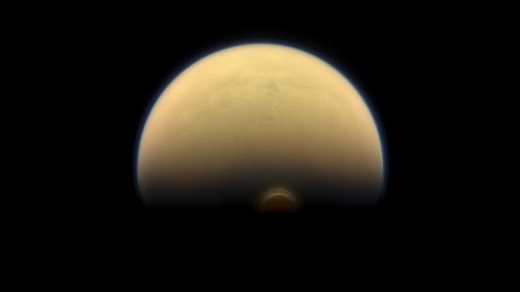
Image: Slipping into shadow, the south polar vortex at Saturn’s moon Titan still stands out against the orange and blue haze layers that are characteristic of Titan’s atmosphere. Images like this, from NASA’s Cassini spacecraft, lead scientists to conclude that the polar vortex clouds form at a much higher altitude — where sunlight can still reach — than the lower-altitude surrounding haze. This view looks towards the trailing hemisphere of Titan (5,150 kilometers across). North on Titan is up and rotated 17 degrees to the left. Images taken using red, green and blue spectral filters were combined to create this natural-color view. The image was taken with the Cassini spacecraft narrow-angle camera on July 30, 2013. Credit: NASA/JPL-Caltech/Space Science Institute.
Within the polar vortex over the south pole, trace gases are accumulating as sunlight diminishes. Here again the parallel is direct. We now see, according to this Europlanet news release, the appearance of complex hydrocarbons and nitriles like methylacetylene and benzene, which were before observed only at high northern latitudes. Coustenis again:
“We’ve had the chance to witness the onset of winter from the beginning and are approaching the peak time for these gas-production processes in the southern hemisphere. We are now looking for new molecules in the atmosphere above Titan’s south polar region that have been predicted by our computer models. Making these detections will help us understand the photochemistry going on.”
While the onset of winter led to a swift temperature drop of 40 degrees Celsius in the stratosphere over the southern pole, the warming effects in the northern hemisphere as the seasons change have been much more gradual, with a 6-degree rise since 2014. In these northerly regions, Cassini has found trace gases that persist into the summer. Although these should eventually disappear, Coustenis says an area of depleted molecular gas and aerosols has emerged across the entire northern hemisphere at an altitude of 400-500 kilometers.
High altitudes on Titan are, in other words, complicated, and while we’re developing a consistent picture thanks to Cassini’s twelve years of observations, these complex effects bear further study. Remember that although we’re entering Cassini’s last year, we have a two-part endgame to go through that involves a final close flyby of Titan to reshape the spacecraft’s orbit. In its new trajectory, Cassini will make 22 passes through the gap between the rings and the planet.
The so-called Grand Finale begins in April of 2017 and takes us to a first dive through the ring/planet gap on April 27. It should be quite a ride, with the closest observations ever made of Saturn, including mapping the planet’s magnetic and gravity fields at high precision, along with samples of particles in the main rings and gases from Saturn’s outer atmosphere. In addition, we should get spectacular views of the rings when, in November of this year, Cassini begins a series of 20 passes just beyond the outer edge of the main rings. Cassini has not gotten this close to the rings since its arrival at Saturn in 2004; we’ll see the ring structure at high resolution. The spacecraft’s final dive into Saturn is planned for September 15, 2017.
“While it will be sad to say goodbye, Cassini’s final act is like getting a whole new mission in its own right,” said Linda Spilker, Cassini project scientist at NASA’s Jet Propulsion Laboratory, Pasadena, California. “The scientific value of the F ring and Grand Finale orbits is so compelling that you could imagine an entire mission to Saturn designed around what we’re about to do.”

New Work on Planet Nine
Considering how long we’ve been thinking about a massive planet in the outer Solar System — and I’m going all the way back to Percival Lowell’s Planet X here — the idea that we might find the hypothetical Planet Nine in just three years or so is a bit startling. But Caltech’s Mike Brown and colleague Konstantin Batygin, who predicted the existence of the planet last January based on its effects on Kuiper Belt objects, are continuing to search the putative planet’s likely orbital path, hoping for a hit within the next few years, a welcome discovery if it happens.
The duo are working with graduate student Elizabeth Bailey, lead author of a new study being discussed at the American Astronomical Society’s Division for Planetary Sciences meeting in Pasadena, which is occurring in conjunction with the European Planetary Science Congress. The new paper is all about angles and alignments, focusing on the fact that the relatively flat orbital plane of the planets is tilted about six degrees with respect to the Sun. That’s an oddity, and Planet Nine, hypothesized to be about ten times the mass of the Earth and in an orbit averaging 20 times Neptune’s distance from the Sun, just may be the cause.
The calculations on display in the new paper depict a planet some 30 degrees out of alignment with the orbital plane of the other planets. That can help to explain orbital observations of Kuiper Belt objects, but also the unusual system-wide tilt, which stands out because of the assumed formation of the planets through the collapse of a spinning cloud into a disk and, eventually, a collection of planets orbiting the Sun. We would expect the angular momentum of the planets to maintain a rough alignment with the Sun along the orbital plane.
Unless, of course, something is disrupting the system. Throw in the angular momentum of Planet Nine, based on its assumed mass and distance from the Sun, and profound effects on the system’s spin become evident, creating a long-term wobble that shows up in the system’s tilt. As Bailey puts it, “Because Planet Nine is so massive and has an orbit tilted compared to the other planets, the Solar System has no choice but to slowly twist out of alignment.”
And this from the paper:
… a solar obliquity of order several degrees is an expected observable effect of Planet Nine. Moreover, for a range of masses and orbits of Planet Nine that are broadly consistent with those predicted by Batygin & Brown (2016); Brown & Batygin (2016), Planet Nine is capable of reproducing the observed solar obliquity of 6 degrees, from a nearly coplanar configuration. The existence of Planet Nine therefore provides a tangible explanation for the spin orbit misalignment of the solar system.
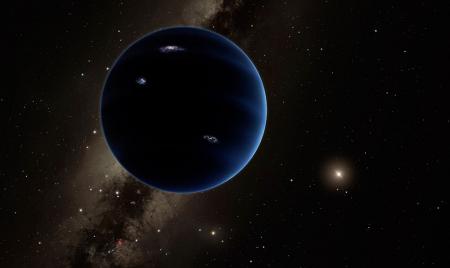
Image: This artistic rendering shows the distant view from Planet Nine back towards the sun. The planet is thought to be gaseous, similar to Uranus and Neptune. Hypothetical lightning lights up the night side. Credit: Caltech/R. Hurt (IPAC).
The six-degree tilt we see between planetary disk and Sun thus fits into the team’s calculations regarding Planet Nine’s size and distance from the central star. And if this does indeed turn out to be the explanation, speculation will then center on how Planet Nine came to be so far out of line with the other planets. We know that gravitational interactions in young planetary systems can sometimes result in disruption, causing some planets to be thrown out of their systems, and others to be moved into distant orbits. Such gravitational byplay may well be the reason for Planet Nine’s unusual position. Now we just need to discover the planet.
I also want to mention that Renu Malhotra (University of Arizona) and team have continued their analysis of a possible Planet Nine, likewise presenting their results at the AAS/EPSC meeting in Pasadena. Through analysis of what they call ‘extreme Kuiper Belt Objects’ —on eccentric orbits with aphelia hundreds of AU out — the team finds a clustering of orbital parameters that may point to the existence of a planet of 10 Earth masses with an aphelion of more than 660 AU. Two orbital planes seem possible, one at 18 degrees offset from the mean plane, the other inclined at 48 degrees.
Dr. Malhotra confirmed in an email this morning that her own constraints on the current position of this possible planet line up with Mike Brown and team at Caltech. But her team continues to point out that we have no detection at this point, and much to learn about the orbits of the Kuiper Belt objects under study. From her paper:
…we note that the long orbital timescales in this region of the outer solar system may allow formally unstable orbits to persist for very long times, possibly even to the age of the solar system, depending on the planet mass; if so, this would weaken the argument for a resonant planet orbit. In future work it would be useful to investigate scattering efficiency as a function of the planet mass, as well as dynamical lifetimes of non-resonant planet-crossing orbits in this region of the outer system. Nevertheless, the possibility that resonant orbital relations could be a useful aid to prediction and discovery of additional high mass planets in the distant solar system makes a stimulating case for renewed study of aspects of solar system dynamics, such as resonant dynamics in the high eccentricity regime, which have hitherto garnered insufficient attention.
The Bailey, Batygin & Brown paper is “Solar Obliquity Induced by Planet Nine,” accepted for publication in the Astrophysical Journal (preprint). The Malhotra paper is Malhotra, Volk & Wang, “Coralling a Distant Planet with Extreme Resonant Kuiper Belt Objects,” Astrophysical Journal Letters Vol. 824, No. 2 (20 June 2016). Abstract / preprint.

New Horizons: Looking Further Out
We’re getting close on New Horizons data, all of which should be downlinked as of this weekend. Although that’s a welcome marker, it hardly means the end of news from the doughty spacecraft. For one thing, we have years of analysis ahead of us as we bring the abundant data from the spacecraft’s instrument packages into focus. For another, we’re still in business out there in the Kuiper Belt, heading for that interesting object 2014 MU69.
Who knows what will turn up at the latter, given our propensity to be surprised at every turn in interplanetary exploration, from Triton’s volcanic plains to fabulously fractured Miranda. And, of course, Pluto and Charon themselves, which turned out to be so interesting that Alan Stern, principal investigator for New Horizons, is already talking about future missions there.
But back to 2014 MU69, which has continued to be the subject of Hubble observations even as New Horizons homes in on the object. As this news release from the mission points out, MU69 is the smallest KBO ever to have its color measured, a reddish hue that confirms its identity as part of the ‘cold classical’ region of the Kuiper Belt. These are objects with low orbital eccentricity and inclination that are not in orbital resonance with Neptune. Reddish-brown tholins formed by solar radiation interacting with simple organic compounds are common here.
“The reddish color tells us the type of Kuiper Belt object 2014 MU69 is,” says Amanda Zangari, a New Horizons post-doctoral researcher from Southwest Research Institute. “The data confirms that on New Year’s Day 2019, New Horizons will be looking at one of the ancient building blocks of the planets.”
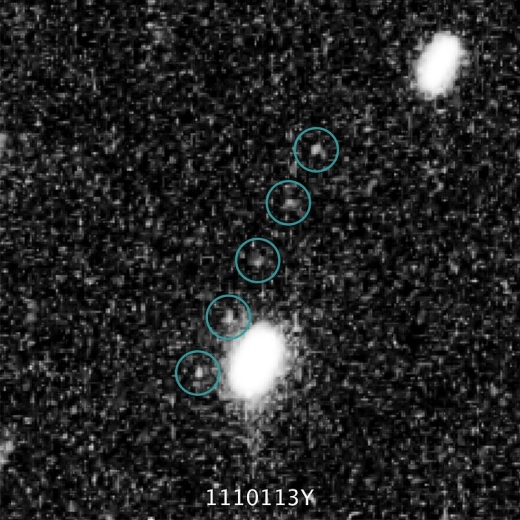
Image: 2014 MU69 travels diagonally across a dense field of stars and noise in the background. Credit: NASA, ESA, SwRI, JHU/APL, and the New Horizons KBO Search Team.
New Horizons has now covered a third of its distance from Pluto to MU69, with the target approximately a billion kilometers away. The analysis of New Horizons data, meanwhile, is turning up interesting things on Charon, where we find landslides, a feature that has not yet been spotted on Pluto’s surface, although we’ve found them on worlds as diverse as Mars and Iapetus. The Charon landslides are the farthest ever observed from the Sun.
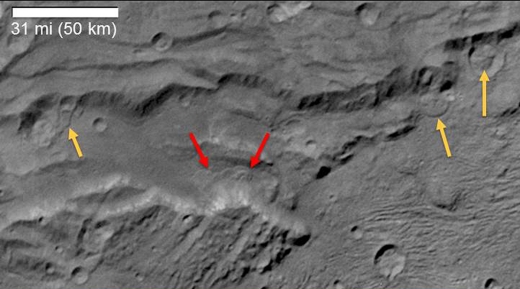
Image: Scientists from NASA’s New Horizons mission have spotted signs of long run-out landslides on Pluto’s largest moon, Charon. This image of Charon’s informally named Serenity Chasma was taken by New Horizons’ Long Range Reconnaissance Imager (LORRI) on July 14, 2015, from a distance of 78,717 kilometers. Arrows mark indications of landslide activity. Credit: NASA/Johns Hopkins University Applied Physics Laboratory/Southwest Research Institute.
Likewise, we learn that while Pluto’s atmosphere is hazy but largely cloud-free, a handful of possible clouds have turned up in New Horizons imagery. That would point to an atmosphere still more complex than expected. And the variations in surface brightness on Pluto itself are telling. Some of these regions, particularly in Pluto’s now famous heart-shaped region, are among the most reflective in the Solar System. This has implications for what may be occurring on another deep space object, says Bonnie Buratti (JPL), a co-investigator on the New Horizons science team:
“That brightness indicates surface activity. Because we see a pattern of high surface reflectivity equating to activity, we can infer that the dwarf planet Eris, which is known to be highly reflective, is also likely to be active.”
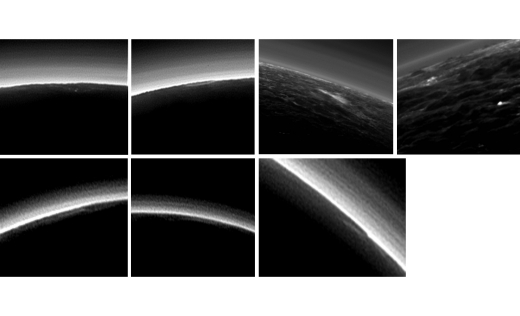
Image: Pluto’s present, hazy atmosphere is almost entirely free of clouds, though scientists from NASA’s New Horizons mission have identified some cloud candidates after examining images taken by the New Horizons Long Range Reconnaissance Imager and Multispectral Visible Imaging Camera, during the spacecraft’s July 2015 flight through the Pluto system. All are low-lying, isolated small features-no broad cloud decks or fields – and while none of the features can be confirmed with stereo imaging, scientists say they are suggestive of possible, rare condensation clouds. Credit: NASA/Johns Hopkins University Applied Physics Laboratory/Southwest Research Institute.
We’re a long way from through with New Horizons, which should make its flyby of 2014 MU69 on January 1, 2019 after the series of four course changes that adjusted its trajectory. We may have other outer system news to discuss as the joint meeting of the American Astronomical Society Division for Planetary Sciences and European Planetary Science Congress in Pasadena continues this week. But for now, I particularly like Alan Stern’s words:
“We’re excited about the exploration ahead for New Horizons, and also about what we are still discovering from Pluto flyby data. Now, with our spacecraft transmitting the last of its data from last summer’s flight through the Pluto system, we know that the next great exploration of Pluto will require another mission to be sent there.”


